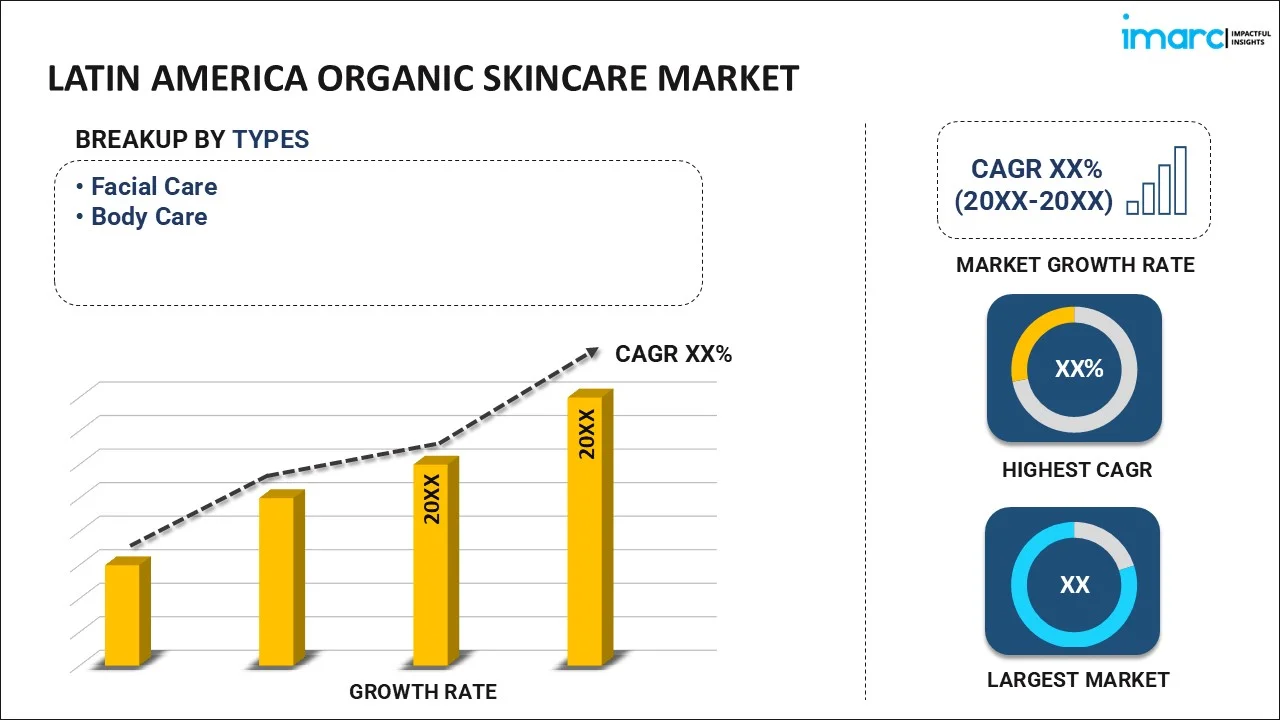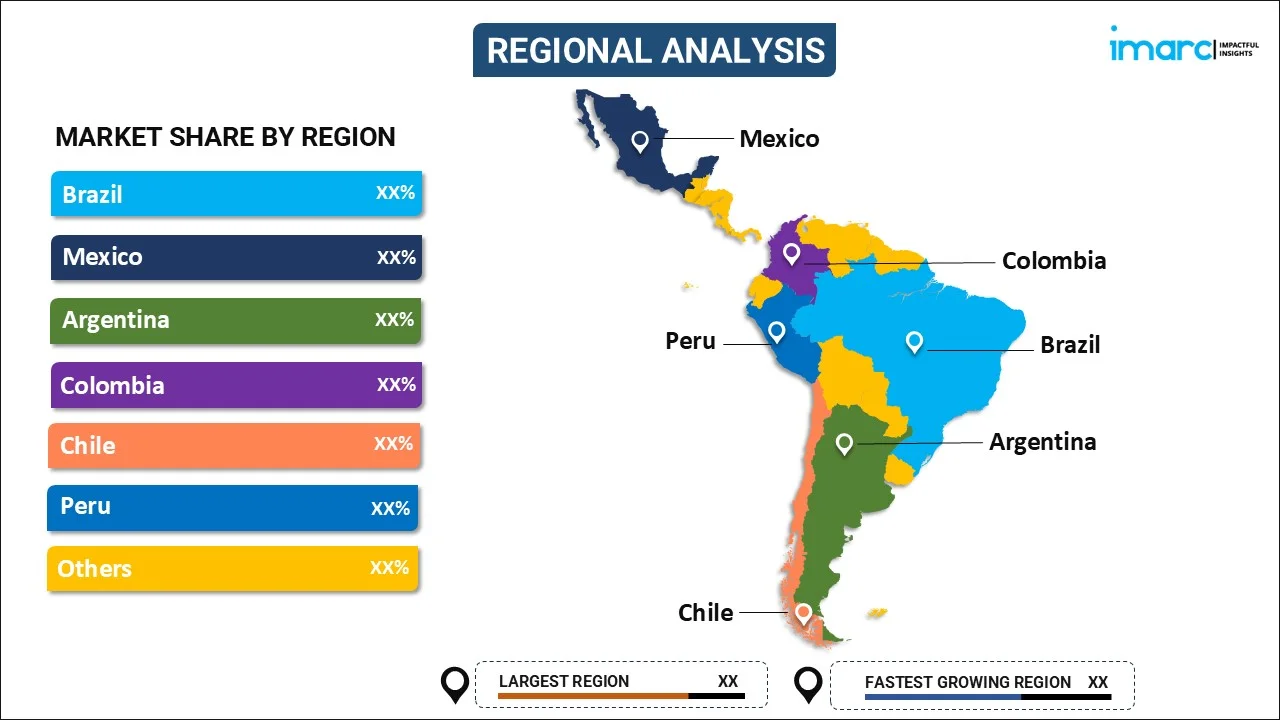
Latin America Organic Skincare Market Size, Share, Trends and Forecast by Type, Distribution Channel, and Region, 2025-2033
Latin America Organic Skincare Market Overview:
The Latin America organic skincare market size reached USD 916.57 Million in 2024. Looking forward, IMARC Group expects the market to reach USD 1,918.74 Million by 2033, exhibiting a growth rate (CAGR) of 7.92% during 2025-2033. The Latin America organic skincare market has been driven by increasing consumer awareness of natural ingredients, rising disposable incomes, government support for sustainable beauty products, and the expansion of major brands like Natura & Co, which has strengthened accessibility and innovation in organic skincare across key markets such as Brazil, Mexico, and Colombia.
|
Report Attribute
|
Key Statistics
|
|---|---|
|
Base Year
|
2024 |
|
Forecast Years
|
2025-2033
|
|
Historical Years
|
2019-2024
|
| Market Size in 2024 | USD 916.57 Million |
| Market Forecast in 2033 | USD 1,918.74 Million |
| Market Growth Rate (2025-2033) | 7.92% |
Latin America Organic Skincare Market Trends:
Rising Consumer Awareness about Health and Environmental Sustainability
Over the last few years, Latin American consumers have grown increasingly aware of the health effects of artificial ingredients used in personal care products and the ecological footprint of conventional agriculture. As a result, there has been a rapid rise in demand for organic personal care products that are seen as safer and greener. A prime instance of this is the creation of markets such as "Mercado El 100" in Mexico City. Since 2010, this collaborative market has attracted more than 50 organic producers and artisans and sells products grown and made within 100 kilometers of the city. The market is open each Sunday, allowing consumers to shop for fresh, organic produce, including skin products. The success of these markets represents an increasing number of consumers who value organic and locally produced items. In Argentina, the export group "Organic Latin America" has broadened its activities to accommodate the growing demand for organic products. They created alliances with manufacturers in different regions, producing organic rice in Corrites and Entre Ríos, as well as organic sunflower, wheat, and barley in other provinces. Not only does it serve domestic consumers, but it also puts Argentina as the main exporter of organic products, including skin care products.
Governmental Support for Organic Agriculture and Production
Governments in Latin America are seeing the advantages of organic farming and enacting policies to encourage its development, which, in turn, supports the organic skincare market. The "Latin American Economic Outlook 2023" report stresses the importance of an ambitious and inclusive investment agenda to foster sustainable development in the region. This entails increasing domestic and external investments in organic agriculture and other areas that can result in high-quality raw materials for organic skincare. Such policy efforts seek to tap the resources and biological diversity of the region toward sustainable economic opportunities. In Argentina, the government has been in dialogue with industry leaders to encourage organic production. For example, the Argentine Embassy in Japan organized a meeting with Christian Martinez, President of Organic Latin America, to discuss how to increase the export of organic products. This partnership serves to demonstrate the government's effort to help organic producers and raise their influence in global markets. These government initiatives play a key role in developing a favorable climate for the growth of the organic skincare industry, offering assistance in the form of policies, investments, and global partnerships. Overall, the growth of the Latin American organic skincare market is mainly due to increasing consumer awareness of health and sustainability, along with active government support for organic farming and production. These conditions collectively promote a healthy ecosystem for organic skincare product development and consumption within the region.
Latin America Organic Skincare Market Segmentation:
IMARC Group provides an analysis of the key trends in each segment of the market, along with forecasts at the region/country level for 2025-2033. Our report has categorized the market based on type and distribution channel.
Type Insights:

- Facial Care
- Cleansers
- Moisturizers and Oils/Serums
- Other Facial Care Products
- Body Care
- Body Lotions
- Body Wash
- Other Body Care Products
The report has provided a detailed breakup and analysis of the market based on the type. This includes facial care (cleansers, moisturizers and oils/serums, and other facial care products), and body care (body lotions, body wash, and other body care products).
Distribution Channel Insights:
- Supermarkets/Hypermarkets
- Convenience Stores
- Specialist Stores
- Online Retail Stores
- Others
A detailed breakup and analysis of the market based on the distribution channel have also been provided in the report. This includes supermarkets/hypermarkets, convenience stores, specialist stores, online retail stores, and others.
Regional Insights:

- Brazil
- Mexico
- Argentina
- Colombia
- Chile
- Peru
- Others
The report has also provided a comprehensive analysis of all the major regional markets, which include Brazil, Mexico, Argentina, Colombia, Chile, Peru, and others.
Competitive Landscape:
The market research report has also provided a comprehensive analysis of the competitive landscape. Competitive analysis such as market structure, key player positioning, top winning strategies, competitive dashboard, and company evaluation quadrant has been covered in the report. Also, detailed profiles of all major companies have been provided.
Latin America Organic Skincare Market News:
- December 2024: Natura & Co revealed its strategy to introduce a franchise model in Mexico, utilizing established brand leaders for growth. The company adjusted its retail approach to match local market tastes, enhancing its footprint in Latin America. This action strengthened the expansion of the organic skincare market in Latin America by enhancing access to eco-friendly beauty products.
- March 2024: Natura enhanced its bio innovation initiatives by allocating USD 68.7 Million for R&D, with 95% of its cosmetic products featuring natural components. This change bolstered consumer confidence in organic skincare items, increasing the demand for sustainable cosmetics in Latin America. Through the combination of scientific progress and sustainability, Natura established itself as a significant contender in the area's organic skincare sector, shaping industry trends and promoting environmentally aware consumer practices.
Latin America Organic Skincare Market Report Coverage:
| Report Features | Details |
|---|---|
| Base Year of the Analysis | 2024 |
| Historical Period | 2019-2024 |
| Forecast Period | 2025-2033 |
| Units | Million USD |
| Scope of the Report |
Exploration of Historical Trends and Market Outlook, Industry Catalysts and Challenges, Segment-Wise Historical and Future Market Assessment:
|
| Types Covered |
|
| Distribution Channels Covered | Supermarkets/Hypermarkets, Convenience Stores, Specialist Stores, Online Retail Stores, Others |
| Regions Covered | Brazil, Mexico, Argentina, Colombia, Chile, Peru, Others |
| Customization Scope | 10% Free Customization |
| Post-Sale Analyst Support | 10-12 Weeks |
| Delivery Format | PDF and Excel through Email (We can also provide the editable version of the report in PPT/Word format on special request) |
Key Questions Answered in This Report:
- How has the Latin America organic skincare market performed so far and how will it perform in the coming years?
- What is the breakup of the Latin America organic skincare market on the basis of type?
- What is the breakup of the Latin America organic skincare market on the basis of distribution channel?
- What are the various stages in the value chain of the Latin America organic skincare market?
- What are the key driving factors and challenges in the Latin America organic skincare market?
- What is the structure of the Latin America organic skincare market and who are the key players?
- What is the degree of competition in the Latin America organic skincare market?
Key Benefits for Stakeholders:
- IMARC’s industry report offers a comprehensive quantitative analysis of various market segments, historical and current market trends, market forecasts, and dynamics of the Latin America organic skincare market from 2019-2033.
- The research report provides the latest information on the market drivers, challenges, and opportunities in the Latin America organic skincare market.
- Porter's five forces analysis assist stakeholders in assessing the impact of new entrants, competitive rivalry, supplier power, buyer power, and the threat of substitution. It helps stakeholders to analyze the level of competition within the Latin America organic skincare industry and its attractiveness.
- Competitive landscape allows stakeholders to understand their competitive environment and provides an insight into the current positions of key players in the market.
Need more help?
- Speak to our experienced analysts for insights on the current market scenarios.
- Include additional segments and countries to customize the report as per your requirement.
- Gain an unparalleled competitive advantage in your domain by understanding how to utilize the report and positively impacting your operations and revenue.
- For further assistance, please connect with our analysts.
 Request Customization
Request Customization
 Speak to an Analyst
Speak to an Analyst
 Request Brochure
Request Brochure
 Inquire Before Buying
Inquire Before Buying




.webp)




.webp)












